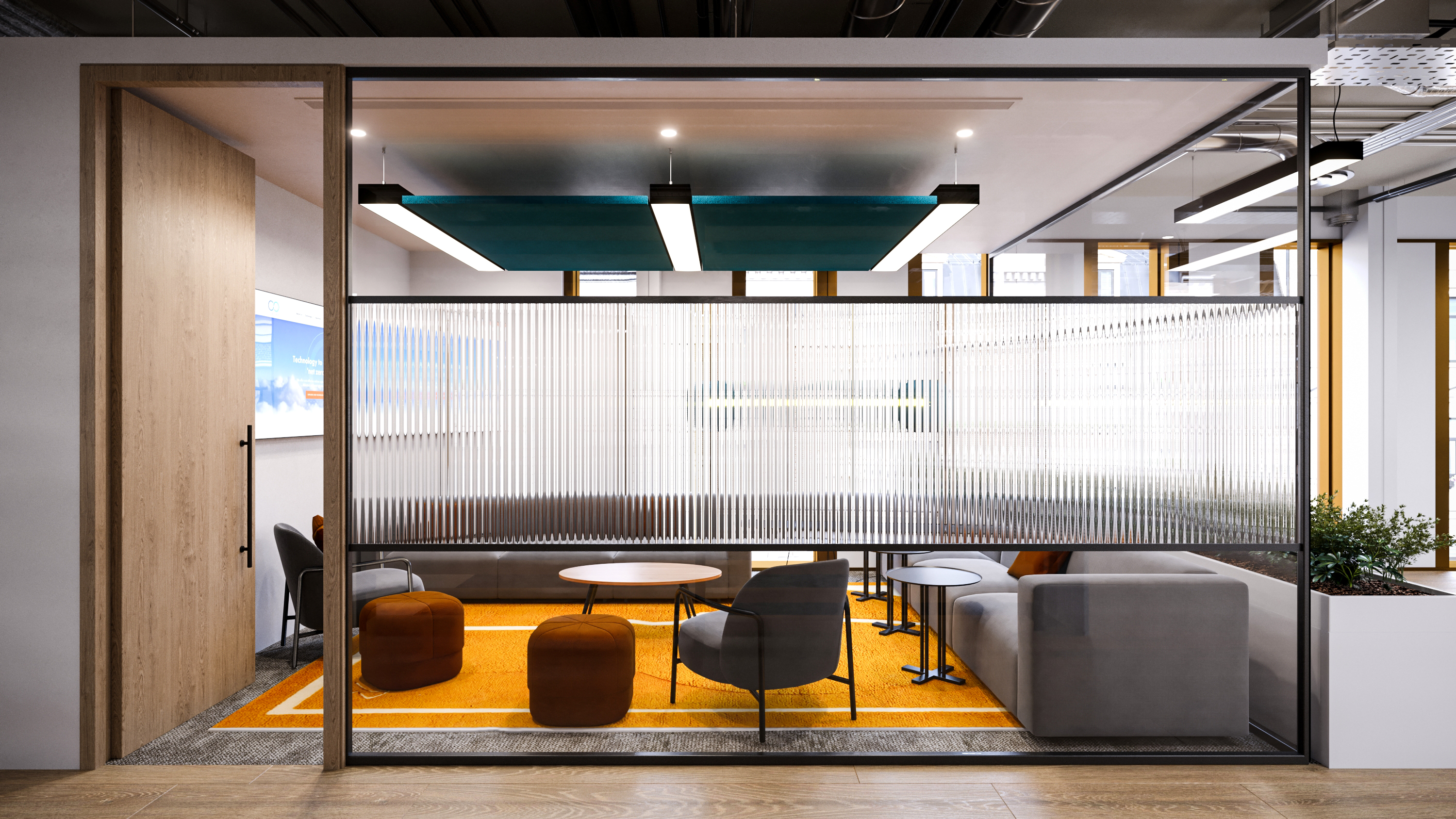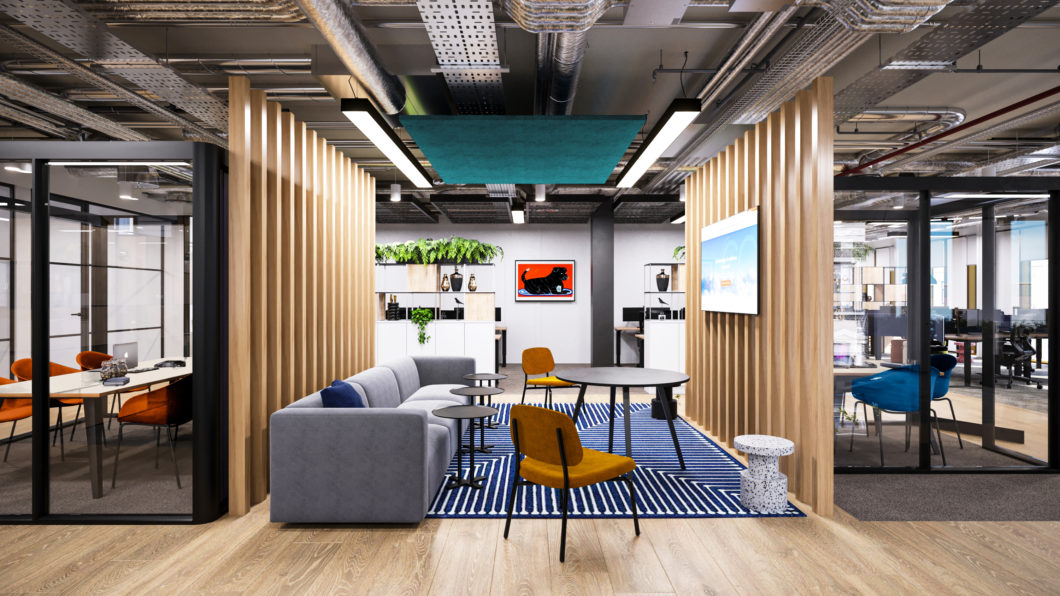Learn how to master your office acoustics to enhance productivity and well-being in your workplace with our top ten tips!
By Making Moves London
December 5, 2024
When creating a productive office environment, acoustics play a crucial role, especially in bustling cities like London. From phones ringing and desk chatter to the sound of the coffee machine, office acoustics have a direct impact on productivity, communication, and well-being.
In this guide, we’ll explore how acoustics affect your space and share practical tips on creating a quieter, more focused work environment. Plus, we’ll show you how Making Moves can help with a space audit to find the perfect office layout for your team.

Office acoustics refer to how sound is managed within a workspace. This includes everything from background noise and echoes to speech clarity and overall sound quality. When acoustics are properly designed, they create a comfortable environment that allows for better communication and concentration.
The key elements that impact office acoustics include:
Understanding these principles is crucial for designing spaces that minimise distractions and boost productivity, which can also enhance workplace culture.
Good acoustics are essential for fostering a productive work environment. Here’s why your business should prioritise them:
Clear communication is key to a successful business. Proper acoustics ensure speech is easily understood, which is especially important during team meetings or collaborative sessions. In contrast, poor acoustics can lead to misunderstandings and inefficient teamwork.
Noise distractions are a major culprit in reduced productivity. Research shows that just one nearby conversation can cause a 66% decrease in productivity for an individual at that moment. By improving acoustics, you can help employees focus better and reduce costly errors.
A noisy office can contribute to stress and fatigue, ultimately affecting employee satisfaction. By implementing acoustic solutions, you create a calmer environment that promotes well-being and reduces workplace stress.

There are several factors that contribute to poor office acoustics, so it’s important to be aware of these when designing your space:
Open-plan offices are increasingly popular due to their collaborative benefits and efficient use of space. However, they can be particularly challenging for sound management. Without proper acoustic treatment, these environments can become noisy and distracting, especially when combined with common sounds like ringing phones or conversations.
Modern office designs often feature sleek, hard surfaces like concrete, glass, or hardwood floors, which, while visually appealing, can significantly amplify noise. These materials reflect sound waves, causing them to bounce around the room, creating distracting echoes and making everyday office sounds—such as conversations, footsteps, or phone calls—more intrusive.
Without sound-absorbing materials like carpets, upholstered furniture, or acoustic panels to soften these effects, noise can travel further and disrupt focus, reducing overall productivity.
High ceilings, while offering a sense of spaciousness and grandeur, can contribute to poor acoustics in office environments. Taller ceilings increase the distance sound has to travel, leading to more reverberation and echoes, especially in open-plan offices. This makes it difficult for sound to dissipate naturally, causing noise to linger and making it harder for employees to focus.
Achieving the right balance in office acoustics is essential for creating a productive and comfortable working environment. If your office is too loud, it becomes difficult for employees to focus, leading to distractions, errors, and reduced efficiency. On the other hand, if the environment is too quiet, even small sounds like typing or coughing can become disproportionately distracting, creating a sense of unease among staff.

Finding the right balance is crucial, and optimum acoustic levels vary depending on the work being done. For focused tasks, noise levels are between 35-45 decibels – such as soft music or light chatter – work best. In collaborative or open-plan spaces, slightly higher levels—around 45-55 decibels—can be acceptable. Interestingly, creativity has been shown to peak around 70 decibels, about the noise level of a busy coffee shop, helping workers immerse themselves in tasks.
For safety, the Health and Safety Executive (HSE) advises that employers provide hearing protection when noise exceeds 85 decibels.
Some employees, especially those who are neurodivergent, may have heightened sensitivities to noise, making it harder to focus in busy environments. Creating varied spaces with sound-mitigating options, such as quiet zones or noise-cancelling solutions, helps maintain inclusivity and comfort for your whole team.
Measuring the acoustic quality of your office space can be complex, as it’s influenced by a variety of factors, including the materials in the space, room layout, and the type of noise present. While simple tools like sound level metres or free smartphone apps like Decibel Pro can give you a rough idea of the noise levels, a comprehensive acoustic assessment is often needed.
The best way to get an accurate picture of your office acoustics is by consulting with an acoustic expert. These professionals are equipped to evaluate everything from reverberation times to noise isolation and can identify areas in need of improvement. They’ll also provide tailored recommendations on how to enhance the acoustic environment, ensuring your office supports productivity and employee well-being.

Now that you understand how crucial good office acoustics are, let’s explore some actionable solutions for your workplace. Here are our top 10 ways to improve your office acoustics and create a workspace that fosters productivity and well-being.
Acoustic panels are an excellent way to absorb sound and reduce echo in large office spaces. They can be mounted on walls or ceilings and come in various designs that blend seamlessly with your office aesthetic. By reducing reverberation, these panels help create a quieter environment, particularly in open-plan offices or meeting rooms.
If you’re working in an open-plan office, acoustic dividers or partitions can be a game-changer. These movable barriers help contain noise by creating mini workspaces. Not only do they reduce noise transmission between employees, but they also offer added privacy, which can improve concentration and productivity. You can also customise the materials used for visual appeal and sound absorption.

Sometimes, complete quiet is needed for deep work or private conversations. Acoustic office pods are soundproof, enclosed spaces designed for focus and privacy. Whether it’s for solo work or small meetings, these pods offer a quiet retreat within the bustling office environment, helping employees focus without distractions.
Don’t underestimate the impact of furniture on office acoustics. Soft, cushioned furniture like sofas, chairs, and even curtains help absorb sound. Choosing upholstered seating, rather than metal or plastic, reduces the amount of noise bouncing around the office. Additionally, incorporating desk padding, such as felt or foam pads, can help reduce sound from desk movements, typing, or other everyday office activities.
Hard surfaces like wood, tile, or concrete can amplify noise as sound waves reflect off them. To reduce noise, consider installing carpets, rugs, or acoustic flooring designed to absorb sound. This helps reduce the noise from footsteps and chair movements, contributing to a quieter overall environment, particularly in high-traffic areas.
Sound masking systems create ambient background noise at a consistent level, helping to ‘mask’ or drown out disruptive sounds like conversations or keyboard clatter. This is especially useful in open-plan offices where even small noises can travel far and disrupt focus. By balancing sound levels, these systems improve privacy and create a calmer working atmosphere.

Want to maintain an open, modern look but still control noise? Acoustic glass partitions could be the answer. These transparent barriers help block sound while keeping a sense of openness and light in your office. They’re ideal for sectioning off meeting rooms or private offices while keeping an airy, collaborative feel throughout the workspace.
Not every part of the office should be bustling with activity. Setting up designated quiet zones allows employees to escape the noise when they need to focus. These areas should be equipped with comfortable, acoustic-friendly furnishings, providing a space where individuals can work without interruptions, perfect for high-focus tasks or decompressing between meetings.
Sometimes, improving acoustics is as simple as reorganising your office layout. Place noisier areas, like collaboration zones or kitchens, farther away from quiet workstations. Grouping spaces with similar noise levels can minimise the impact of louder activities on quieter ones, helping employees stay focused in areas that require concentration.

Plants not only enhance your office’s aesthetic and promote well-being, but they can also help absorb sound and reduce noise levels. Placing plants strategically throughout the office can soften the acoustics, especially in areas with hard surfaces. To find out more benefits of incorporating plants into your office space, read our blog on biophilic design.
By putting these strategies into action, businesses can dramatically improve their office acoustics, boosting productivity and enhancing employee satisfaction. But don’t just take our word for it—let’s explore a real-life example of how Making Moves has successfully transformed office environments for better sound management.

With rapid expansion necessitating more space, Carbon Clean sought a new London office that aligned with its eco-conscious mission. Ensuring their new space met acoustic needs was paramount, particularly for privacy during confidential meetings and facilitating collaboration and focused work.
Making Moves oversaw the design and delivery of this new workspace, which included quiet zones and grade-A acoustics tailored to meet the client’s requirements. We created distinct areas for collaboration and concentration, implementing acoustic partitions and strategically placed plants to help manage sound levels effectively.
Through our comprehensive relocation consultancy and fit-out project management, we ensured that the office environment not only supported productivity but also aligned with Carbon Clean’s commitment to sustainability.
To see more examples of how we’ve helped businesses like Depop and HiBob transform their office spaces, check out our other case studies here.
Creating an office that prioritises good acoustics is essential for productivity and employee well-being. At Making Moves, our expert agents can match you with the perfect property and manage your office fit-out, ensuring your workspace is designed with optimal acoustics in mind.
Contact us today to learn how we can help you create an acoustically sound workspace.

? Source, negotiate and manage entire office moves.
? Dispose, sublet or redesign your office.
?️ Professional, independent support.